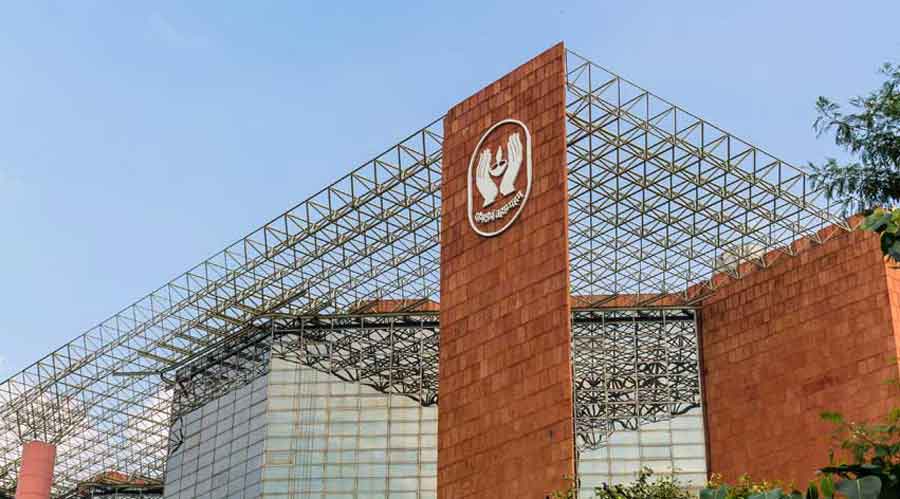The Life Insurance Corporation (LIC) has lifted the veil on what promises to be “the mother of all capital issues” in India.
On Sunday, the state-owned insurer, which describes itself as the fifth-largest life insurer in the world ranked by gross written premium (GWP), filed the draft red herring prospectus (DRHP) for its mammoth share flotation later this year.
The Narendra Modi government intends to come out with the initial public offering (IPO) of the life insurer before the close of the current fiscal on March 31.
The draft document, which must be approved by the market regulator, does not mention the timing of the issue or the pricing.
The IPO will see the Centre offering 31.6 crore shares, or 5 per cent of the insurer’s equity. Since the issue is entirely an offer for sale, all the proceeds will go directly to the government.
In the Union budget presented earlier this month, the government had drastically scaled back its estimation of proceeds from divestment from Rs 1.79 lakh crore in the previous year’s budget estimate to Rs 78,000 crore — raising some doubts over whether the LIC issue would go through by the end of March.
The move to file the prospectus indicates that the government is looking to speed up the public flotation.
“The DRHP of LIC IPO has been filed today with the SEBI,” department of investment and public asset management (Dipam) secretary Tuhin Kanta Pandey tweeted.
A portion of the IPO will be reserved for anchor investors, who will be picked from a pre-IPO bidding process.
Up to 10 per cent of the LIC IPO issue size will be reserved for its policyholders.
Actuarial firm Milliman Advisors LLP India had worked out the embedded value (EV) of LIC, a key metric that is used to determine the valuation of insurance companies.
LIC’s EV as of September 30, 2021, stood at Rs 539,686 crore. The EV is the sum of the present value of all future profits from existing business (or policies) and its net worth (assets minus liabilities).
Observers are also calling the LIC offering India’s “Aramco moment”. The Saudi oil giant had raised $29.4 billion in late 2019 from what was touted as the world’s largest IPO.
Coincidentally, the Saudi giant transferred another 4 per cent of Aramco shares to the Kingdom’s sovereign wealth fund to raise another $80 billion.
The LIC flotation will enter the record books –- and easily exceed that of digital payments giant Paytm which raised Rs 18,300 crore last November.
The document lists several factors that could impact returns on investment – and, therefore, hurt benefits for its policyholders and outcomes for its investors.
The Covid-19 pandemic affected the sales of individual policies, primarily in the fourth quarter of fiscal 2020. The payout of death benefits in the six months ended September 30 last year rose sharply to 14.47 per cent of its total insurance claim.
The life insurer said mortality and morbidity risks had increased after the outbreak of the pandemic -– which may affect the pricing of products if “actual outcomes are not consistent with historical data”. This could affect its profitability and have a “material adverse effect” on its business, operations and financial condition, the document added.
Sources said that estimating LIC’s EV presented a huge challenge because of the crores of policies that the assessors had to trawl to understand factors like policy lapse and mortality indicators.
There are other reasons why LIC offers a watershed moment in India’s capital market history. The state-owned insurer has been synonymous with life insurance since it started providing this cover to Indians more than 65 years ago. The corporation was formed by merging and nationalising 245 private life insurance companies in India on September 1, 1956, with an initial capital of Rs 5 crore.
According to Dipam, LIC has a 66 per cent market share in New Business Premiums (NBP, the sum of the first-year premium and single premium from new business) with 28.3 crore policies and nearly 14 lakh agents as of March 31, 2021.
For the six-month period ended September 30, 2021, LIC earned a consolidated premium of Rs 187,535.3 crore compared with Rs 405,850.8 crore in the full year ended March 31, 2021. Of this, Rs 186,097.2 crore came from India. The first-year premiums stood at Rs 13,399.7 crore against Rs 34,340.9 crore in the year ended March 31, 2021.
It also got Rs 124,473.3 crore as income from interest, dividends and rent against Rs 239,565 crore in the year ended March 31, 2021.
LIC is the largest asset manager in India as of September 30, 2021, with assets under management or AUM (made up of policyholders’ investments, shareholders’ investments and assets held to cover linked liabilities) of Rs 3,955,892.9 crore on a standalone basis.
According to a Crisil report, this was more than 3.3 times the total AUM of all private life insurers in India, 16.2 times than the AUM of the second-largest player in terms of AUM in the Indian life insurance industry, and more than 1.1 times the entire Indian mutual fund industry’s AUM.
Further, its investments in listed equity represented around 4 per cent of the total market capitalisation of NSE as of September 30, 2021.
Currently, there are three listed life insurance players: SBI Life, HDFC Life and ICICI Prudential Life Insurance Company. HDFC Life leads the valuation game with a market cap of Rs 125,726.80 crore.












